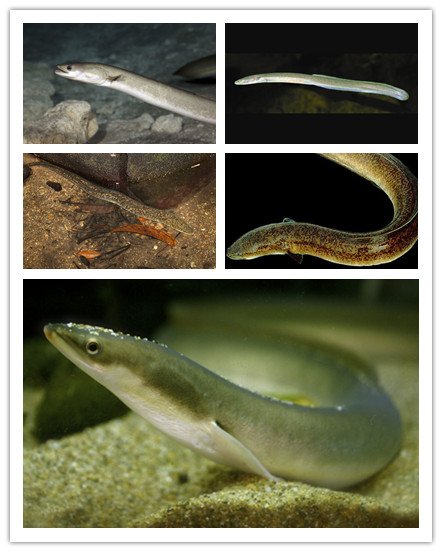Freshwater eel is commonly used in Japanese uangi rice and sushi.
Some people think freshwater eels just live in fresh water all the time, but it's not that simple.
Freshwater eel is a kind of migratory fish, that is, young and adult fish live in fresh water, and migrate to the ocean to spawn after maturity.
The larvae after eggs live in the ocean, and then follow the ocean currents to inland rivers, and continue to grow up in fresh water.
Biologists say there are 18 species of freshwater eels:
 European (Anguilla Anguilla), American (Anguilla rostrata), Japanese (white eel; Anguilla japonica), Australian eel (black eel; Anguilla australis), African eel (Anguilla Mossambica), Perch eel (Anguilla mormorata), Philippine eel (Anguilla mormorata), New Zealand eel (Anguilla Dieffenbachi), Indonesian eel (Anguilla bicolor Pacifica), etc
European (Anguilla Anguilla), American (Anguilla rostrata), Japanese (white eel; Anguilla japonica), Australian eel (black eel; Anguilla australis), African eel (Anguilla Mossambica), Perch eel (Anguilla mormorata), Philippine eel (Anguilla mormorata), New Zealand eel (Anguilla Dieffenbachi), Indonesian eel (Anguilla bicolor Pacifica), etc
Modern scientific research results show that eel is rich in vitamin A and vitamin E, the content of which is 60 times and 9 times that of ordinary fish respectively.
Among them, vitamin A is 100 times that of beef and more than 300 times that of pork. Abundant vitamin A and vitamin E are of great benefit to preventing vision degeneration, protecting liver and restoring energy.
In addition, eel is rich in DHA and EPA, its content is higher than other seafood, meat, DHA is commonly known as "brain gold", is a major component of the growth and maintenance of nervous system cells, is an important component of the brain and retina.
It helps to promote the intelligence and visual development of infants and young children; DHA and EPA have been shown to play an important role in the prevention of cardiovascular disease.
In addition, eel also contains a large amount of calcium, which is also effective in preventing osteoporosis.
Moreover, the skin and meat of eel are rich in collagen, which can improve the beauty and delay aging, so it is called "edible cosmetics". As a result, eels are considered one of the three most valuable and competitive fish in the world
Aquaculture eel
Eels grow in natural environment is very slow, eel specifications from eel seedling to goods generally need to 5 ~ 6 years, and under the condition of artificial cultivation, as a result of the aquaculture environment is superior, feed nutrition, temperature is appropriate, and comprehensive management measures properly, make the growth of eels accelerated dramatically, usually more than 1 year eel can develop to commodity specification
In 2021, China's eel farming area exceeded 10,000 hectares, its aquaculture output was 213,800 tons, and its exports were 159,700 tons, making China the world's largest producer of eel farming and raw material supplier of eel products.
The total output of eel farming in China (mainly American eel and Japanese eel) ranks first in the world, accounting for about 70% of the world's total output. Eels are mainly exported to Japan, South Korea, Southeast Asia, Europe, the United States and Canada and other countries and regions.
Eel farming in China is mainly concentrated in guangdong, Fujian, Jiangsu, Zhejiang and other coastal provinces, and has formed an export-oriented industry integrating eel seedling cultivation, adult eel breeding, feed production, roasted eel and eel by-product processing, and export
Item: | freshiwater eel |
Style: | live |
Scientific name: | Anguilla japonica, Anguilla Rostrata |
Size: | 15P/20P/25P/30P/35P/40P/45P/50P/60P/70P/80P/90P/100P |
Ingredient: | Freshwater eel |
Heat Treatment | 80-120 degree for 27minutes |
Sauce: | without unagi sauce |
Cooking method: | Ready to eat after defrosting |
Taste: | live |
Packing: | Packed in bulk,5kg/box*2/10kgs/ctn |
Grade: | A |
Net Weight(kg): | 10kg/CTN |
Storage: | -18℃ |
Shelf life: | 720 days |
Place of Origin: | Guangdong, China |
Certificate: | FDA,HACCP,ISO,HALAL,CCPIT |
Lead Time: | 30-45 days |
Delivered: | By air |
Loading port: | Shen zhen/Xia men |
Shipment: | By sea |
MOQ: | 8500kg (1*20GP)/22000kg (1*40HQ) |
Carton Size: | 428*335*190mm |
Payment: | L/C,T/T |